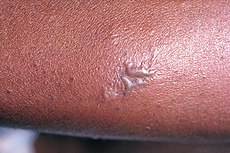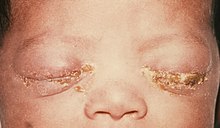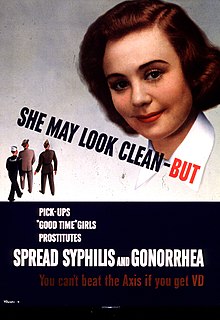Gonorrhea
From Wikipedia, the free encyclopedia
"The clap" redirects here. For other uses, see Clap.
| Gonorrhea | |
|---|---|

Gonococcal lesion on the skin
| |
| Classification and external resources | |
| Specialty | Infectious disease |
| ICD-10 | A54 |
| ICD-9-CM | 098 |
| DiseasesDB | 8834 |
| MedlinePlus | 007267 |
| eMedicine | article/782913 |
| Patient UK | Gonorrhea |
| MeSH | D006069 |
In the US testing all women who are sexually active and less than 25 years of age each year is recommended.[2] This same recommendation applies in men who have sex with men.[2]
Gonorrhea can be prevented with the use of condoms.[2] Treatment is usually with ceftriaxone, as resistance has developed to many previously used antibiotics. Ceftriaxone is typically given in combination with either azithromycin or doxycycline, as gonorrhea infections may occur along with chlamydia, an infection that ceftriaxone does not treat. Some strains of gonorrhea have begun showing resistance to this treatment,[3] which will make infection more difficult to treat.[4] Retesting is recommended three months after treatment.[2]
An estimated 88 million cases of gonorrhea occur each year, out of the 448 million new cases of all curable STI each year – that also includes syphilis, chlamydia and trichomoniasis.[5] Infections in women most commonly occur when they are young adults.[2] As of 2010, it caused about 900 deaths, down from 1,100 in 1990.[6]
Contents
[hide]Signs and symptoms
Half of women with gonorrhea do not have symptoms, whereas others have vaginal discharge, lower abdominal pain, or pain with intercourse.[7][8] Most infected men with symptoms have inflammation of the penile urethra associated with a burning sensation during urination and discharge from the penis.[7] In men, discharge with or without burning occurs in half of all cases and is the most common symptom of the infection.[9] Men and women can acquire gonorrhea of the throat from performing oral sex on an infected partner, usually a male partner. Such infection does not produce symptoms in 90% of cases, and produces a sore throat in the remaining 10%.[10][11] In advanced cases, gonorrhea may cause a general feeling of tiredness similar to other infections.[9] It is also possible for an individual to have an allergic reaction to the bacteria, in which case any appearing symptoms will be greatly intensified.[9]The incubation period is 2 to 14 days, with most symptoms appearing between 4 and 6 days after infection. Rarely, gonorrhea may cause skin lesions and joint infection (pain and swelling in the joints) after traveling through the blood stream (see below). Very rarely it may settle in the heart causing endocarditis or in the spinal column causing meningitis (both are more likely among individuals with suppressed immune systems, however).[11]
Cause

Multiple views of a Neisseria gonorrhoeae bacterium, which causes gonorrhea.
Diagnosis
Traditionally, gonorrhea was diagnosed with gram stain and culture; however, newer polymerase chain reaction (PCR)-based testing methods are becoming more common.[8][17] In those failing initial treatment, culture should be done to determine sensitivity to antibiotics.[18] All people testing positive for gonorrhea should be tested for other sexually transmitted diseases such as chlamydia, syphilis, and human immunodeficiency virus.[18]Screening
The United States Preventive Services Task Force recommends screening for gonorrhea in women at increased risk of infection, which includes all sexually active women younger than 25 years. Extragenital gonorrhea and chlamydia is highest in men who have sex with men. Gonorrheal infections in young women are missed with genital-only testing.[19]Screening for gonorrhea in women who are (or intend to become) pregnant, and who are found to be at high risk for sexually transmitted diseases, is recommended as part of prenatal care in the United States.[20]
Prevention
See also: Safe sex
As with most sexually transmitted diseases, the risk of infection can be reduced significantly by the correct use of condoms and can be removed almost entirely by limiting sexual activities to a mutually monogamous relationship with an uninfected person.[21][22]Management

Penicillin entered mass production in 1944 and revolutionized the treatment of several venereal diseases.
Because of increasing rates of antibiotic resistance local susceptibility patterns must be taken into account when deciding on treatment.[18] Many antibiotics that were once effective including penicillin, tetracycline, and fluoroquinolones are no longer recommended because of high rates of resistance.[18] Resistance to cefixime has reached a level such that it is no longer recommended as a first-line agent in the United States, and if it is used a person should be tested again after a week to determine whether the infection still persists.[23] Cases of resistance to ceftriaxone have been reported but are still rare,[18] though public health officials are concerned that an emerging pattern of resistance may predict a global epidemic.[3]
The UK's Health Protection Agency reported that 2011 saw a slight drop in gonorrhea antibiotic resistance, the first in 5 years.[24]
It is recommended that sexual partners be tested and potentially treated.[18] One option for treating sexual partners of people infected is patient-delivered partner therapy (PDPT), which involves providing prescriptions or medications to the person to take to his/her partner without the healthcare provider's first examining him/her.[25]
The United States' Centers for Disease Control and Prevention (CDC) currently recommend that individuals who have been diagnosed and treated for gonorrhea avoid sexual contact with others until at least one week past the final day of treatment in order to prevent the spread of the bacterium.[26] Also, previous infection does not confer any immunity, and a person who has been infected can easily become infected again by exposure to someone who is a carrier for the bacterium, whether or not that person has any infectious signs or symptoms of their own.
Like the bacteria that cause syphilis, these fragile, "fastidious" bacteria cannot sustain themselves outside the body and will rapidly die within minutes to hours.[9][27] Soap and water can effectively remove the bacteria from the hands, and washing bedding and clothing is seldom necessary.[medical citation needed] The chlorine of most swimming pools destroys it immediately.[medical citation needed]
Prognosis

If not treated gonococcal ophthalmia neonatorum will develop in 28% of infants born to women with gonorrhea.[28]
In men, inflammation of the epididymis, prostate gland, and urethra can result from untreated gonorrhea.[29] In women, the most common result of untreated gonorrhea is pelvic inflammatory disease. Other complications include inflammation of the tissue surrounding the liver,[29] a rare complication associated with Fitz-Hugh-Curtis syndrome; septic arthritis in the fingers, wrists, toes, and ankles; septic abortion; chorioamnionitis during pregnancy; neonatal or adult blindness from conjunctivitis; and infertility. Men who have had a gonorrhea infection have an increased risk of getting prostate cancer.[16]
Newborn babies coming through the birth canal are given erythromycin ointment in the eyes to prevent blindness from infection. The underlying gonorrhea should be treated; if this is done then usually a good prognosis will follow.
Among persons in the United States between 14 and 39 years of age, 46% of people with gonorrheal infection also have chlamydial infection.[30]
Epidemiology

Disability-adjusted life year for gonorrhea per 100, 000 inhabitants.
no data
<13
13-26
26-39
39-52
52-65
65-78
|
78-91
91-104
104-117
117-130
130-143
>143
|
In the United Kingdom, 196 per 100,000 males 20 to 24 years old and 133 per 100,000 females 16 to 19 years old were diagnosed in 2005.[7] In 2013, the CDC estimated that more than 820,000 people in the United States get a new gonorrheal infections each year. Fewer than half of these infections are reported to CDC. In 2011, 321, 849 cases of gonorrhea were reported to the CDC. After the implementation of a national gonorrhea control program in the mid-1970s, the national gonorrhea rate declined from 1975 to 1997. After a small increase in 1998, the gonorrhea rate has decreased slightly since 1999. In 2004, the rate of reported gonorrheal infections was 113. 5 per 100, 000 persons.[31]
In the US, it is the second-most-common bacterial sexually transmitted infections; chlamydia remains first.[32][33] According to the CDC, "Overall, African Americans are most affected by gonorrhea. Blacks accounted for 69% of all gonorrhea cases in 2010."[34]
History

During World War II, the U.S. government used posters to warn military personnel about the dangers of gonorrhea and other sexually transmitted infections.
It has been suggested that mercury was used as a treatment for gonorrhea. Surgeons' tools on board the recovered English warship the Mary Rose included a syringe that, according to some, was used to inject the mercury via the urinary meatus into any unfortunate crewman suffering from gonorrhea. The name "the clap", in reference to the disease, is recorded as early as the sixteenth century.[1][36]
Silver nitrate was one of the widely used drugs in the 19th century, but it became replaced by Protargol. Arthur Eichengrün invented this type of colloidal silver, which was marketed by Bayer from 1897 on. The silver-based treatment was used until the first antibiotics came into use in the 1940s.[37][38]
The exact time of onset of gonorrhea as prevalent disease or epidemic cannot be accurately determined from the historical record. One of the first reliable notations occurs in the Acts of the (English) Parliament. In 1161, this body passed a law to reduce the spread of "...the perilous infirmity of burning. "[39] The symptoms described are consistent with, but not diagnostic of, gonorrhea. A similar decree was passed by Louis IX in France in 1256, replacing regulation with banishment.[40] Similar symptoms were noted at the siege of Acre by Crusaders.
Coincidental to, or dependent on, the appearance of a gonorrhea epidemic, several changes occurred in European medieval society. Cities hired public health doctors to treat afflicted patients without right of refusal. Pope Boniface rescinded the requirement that physicians complete studies for the lower orders of the Catholic priesthood.[citation needed]
Medieval public health physicians in the employ of their cities were required to treat prostitutes infected with the "burning", as well as lepers and other epidemic victims.[41] After Pope Boniface completely secularized the practice of medicine, physicians were more willing to treat a sexually transmitted disease.[citation needed]
Human experiments were conducted by the United States in Guatemala from 1946 to 1948 to find a cure for syphilis and gonorrhea. The United States formally apologized to Guatemala in 2010.[citation needed]
Research
| This section needs additional citations for verification. (January 2015) |
References
- ^ Jump up to: a b Oxford English Dictionary
- ^ Jump up to: a b c d e Workowski, KA; Bolan, GA (5 June 2015). "Sexually transmitted diseases treatment guidelines, 2015.". MMWR. Recommendations and reports : Morbidity and mortality weekly report. Recommendations and reports / Centers for Disease Control 64 (RR-03): 1–137. PMID 26042815.
- ^ Jump up to: a b Groopman, Jerome (2012-10-01). "Sex and the Superbug". The New Yorker. LXXXVIII (30): 26–31. Retrieved 2012-10-13.
...public-health experts [see]...the emergence of a strain of gonorrhea that is resistant to the last drug available against it, and the harbinger of a sexually transmitted global epidemic.
- Jump up ^ "Antibiotic-Resistant Gonorrhea". Centers for Disease Control and Prevention. May 8, 2013. Retrieved May 12, 2013.
- ^ Jump up to: a b Emergence of multi-drug resistant Neisseria gonorrhoeae (Report). World Health Organisation. 2011. p. 2. Archived from the original (pdf) on 2014-09-12.
- ^ Jump up to: a b Lozano, R (Dec 15, 2012). "Global and regional mortality from 235 causes of death for 20 age groups in 1990 and 2010: a systematic analysis for the Global Burden of Disease Study 2010.". Lancet 380 (9859): 2095–128. doi:10.1016/S0140-6736(12)61728-0. PMID 23245604.
- ^ Jump up to: a b c d e f g h i Moran JS (2007). "Gonorrhoea". Clin Evid (Online) 2007. PMC 2943790. PMID 19454057.
- ^ Jump up to: a b Ljubin-Sternak, Suncanica; Mestrovic, Tomislav (2014). "Review: Clamydia trachonmatis and Genital Mycoplasmias: Pathogens with an Impact on Human Reproductive Health". Journal of Pathogens 2014 (183167). doi:10.1155/204/183167.
- ^ Jump up to: a b c d Brian R. Shmaefsky (1 January 2009). Gonorrhea. Infobase. p. 52. ISBN 978-1-4381-0142-2.
- Jump up ^ Zakher, Bernadette; Cantor MD, Amy G.; Daeges, Monica; Nelson MD, Heidi (16 December 2014). "Review: Screening for Gonorrhea and Chlamydia: A Systematic Review for the U.S. Prevententive Services Task Force". Annals of Internal Medicine 161 (12): 884–894. doi:10.7326/M14-1022.
- ^ Jump up to: a b Marr, Lisa (2007) [1998]. Sexually Transmitted Diseases: A Physician Tells You What You Need to Know (Second ed.). Baltimore, Maryland: Johns Hopkins University. ISBN 978-0-8018-8658-4.
- Jump up ^ Trebach, Joshua D.; Chaulk, C. Patrick; Page, Kathleen R.; Tuddenham, Susan; Ghanem, Khalil G. (2015). "Neisseria gonorrhoeae and Chlamydia trachomatis Among Women Reporting Extragenital Exposures". Sexually Transmitted Diseases 42 (5): 233–239. doi:10.1097/OLQ.0000000000000248. ISSN 0148-5717.
- Jump up ^ Howard Brown Health Center: STI Annual Report, 2009
- Jump up ^ National Institute of Allergy and Infectious Diseases; National Institutes of Health, Department of Health and Human Services (2001-07-20). "Workshop Summary: Scientific Evidence on Condom Effectiveness for Sexually Transmitted Disease (STD) Prevention". Hyatt Dulles Airport, Herndon, Virginia. pp14
- Jump up ^ "webmd – What Can You Catch in Restrooms? -".
- ^ Jump up to: a b Caini, Saverio; Gandini, Sara; Dudas, Maria; Bremer, Viviane; Severi, Ettore; Gherasim, Alin (2014). "Sexually transmitted infections and prostate cancer risk: A systematic review and meta-analysis". Cancer Epidemiology 38 (4): 329–338. doi:10.1016/j.canep.2014.06.002. PMID 24986642.
- Jump up ^ Barry PM, Klausner JD (March 2009). "The use of cephalosporins for gonorrhea: The impending problem of resistance". Expert Opin Pharmacother 10 (4): 555–77. doi:10.1517/14656560902731993. PMC 2657229. PMID 19284360.
- ^ Jump up to: a b c d e f g Deguchi T, Nakane K, Yasuda M, Maeda S (September 2010). "Emergence and spread of drug resistant Neisseria gonorrhoeae". J. Urol. 184 (3): 851–8; quiz 1235. doi:10.1016/j.juro.2010.04.078. PMID 20643433.
- Jump up ^ Meyers D; Wolff T; Gregory K et al. (March 2008). "USPSTF recommendations for STI screening". Am Fam Physician 77 (6): 819–24. PMID 18386598.
- Jump up ^ Health Care Guideline: Routine Prenatal Care. Fourteenth Edition. By the Institute for Clinical Systems Improvement July 2010.
- Jump up ^ section: Prevention
- Jump up ^ section: How can gonorrhea be prevented?
- ^ Jump up to: a b Centers for Disease Control and Prevention, (CDC) (Aug 10, 2012). "Update to CDC's Sexually Transmitted Diseases Treatment Guidelines, 2010: Oral Cephalosporins No Longer a Recommended Treatment for Gonococcal Infections.". MMWR. Morbidity and mortality weekly report 61 (31): 590–4. PMID 22874837.
- Jump up ^ http://www.hpa.org.uk/NewsCentre/NationalPressReleases/2012PressReleases/120912Gonorrhoeatreatmentresistanceriskfalls/
- Jump up ^ "Expedited partner therapy in the management of sexually transmitted diseases". February 2006. Centers for Disease Control and Prevention (CDC).
- Jump up ^ CDC (14 July 2014). "Gonorrhea - CDC Fact Sheet". Retrieved 17 October 2014.
- Jump up ^ George William Hunter; J. Clyde Swartzwelder; David F. Clyde; Thomas Turlay Mackie (1976). Tropical medicine. Saunders. p. 234. ISBN 978-0-7216-4847-7.
- Jump up ^ "Prophylaxis for Gonococcal and Chlamydial Ophthalmia Neonatorum in the Canadian Guide to Clinical Preventative Health Care" (PDF). Public Health Agency of Canada.
- ^ Jump up to: a b Kumar, Vinay; Abbas, Abul K.; Fausto, Nelson; & Mitchell, Richard N. (2007). Robbins Basic Pathology (8th ed.). Saunders Elsevier. pp. 705–706 ISBN 978-1-4160-2973-1
- Jump up ^ Datta, SD; Sternberg, M; Johnson, RE; Berman, S; Papp, JR; McQuillan, G; Weinstock, H (Jul 17, 2007). "Gonorrhea and chlamydia in the United States among persons 14 to 39 years of age, 1999 to 2002.". Annals of internal medicine 147 (2): 89–96. doi:10.7326/0003-4819-147-2-200707170-00007. PMID 17638719.
- Jump up ^ "Gonorrhea – CDC Fact Sheet". CDC. 29 May 2012. Retrieved 2013-12-20.
- Jump up ^ "CDC – STD Surveillance – Gonorrhea". Archived from the original on 2008-03-06. Retrieved 2008-08-21.
- Jump up ^ "CDC Fact Sheet – Chlamydia". Retrieved 2008-08-21.
- Jump up ^ "STD Trends in the United States: 2010 National Data for Gonorrhea, Chlamydia, and Syphilis". Centers for Disease Control and Prevention (CDC). 22 November 2010.
- Jump up ^ [1]
- Jump up ^ Higgins, John (1587). The Mirror for Magistrates. as cited in the Oxford English Dictionary entry for "clap"
- Jump up ^ Max Bender (1898). "Ueber neuere Antigonorrhoica (insbes. Argonin und Protargol)". Archives of Dermatological Research 43 (1): 31–36. doi:10.1007/BF01986890.
- Jump up ^ MedlinePlus Encyclopedia Neonatal Conjunctivitis
- Jump up ^ W Sanger. History of Prostitution. NY, Harper, 1910 .
- Jump up ^ P. LaCroix. The History of Prostitution—Vol. 2. NY, MacMillan, 1931.
- Jump up ^ WE Leiky. History of European Morals. NY, MacMillan, 1926.
External links
| Wikimedia Commons has media related to Gonorrhea. |
| ||
| ||
|


No comments:
Post a Comment